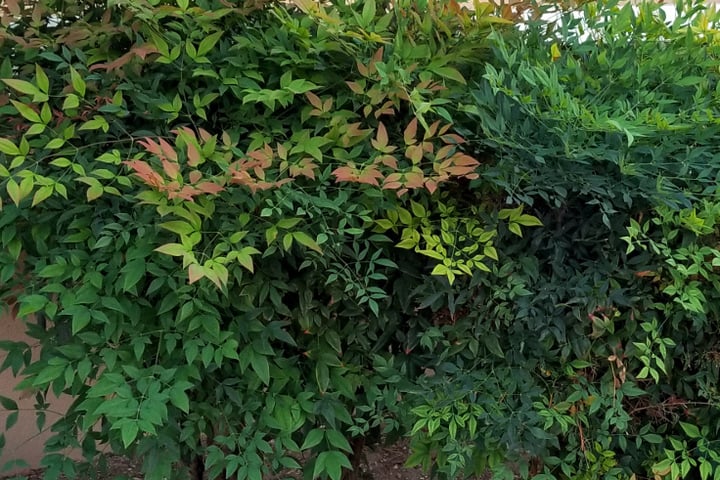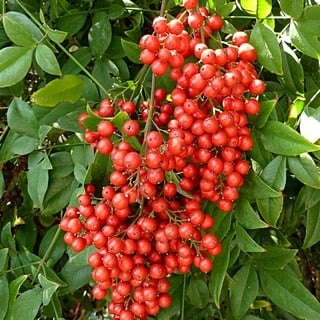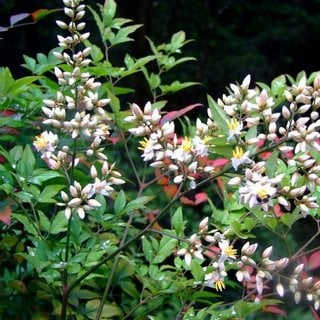Heavenly bamboo is a bamboo look-alike that is often grown for the year-round interest it provides. But be forewarned that it often struggles in desert gardens and is toxic to people, pets, and, in rare instances, to wildlife. Here’s everything you need to know about this Asian native, so you can decide whether it’s a good fit for your garden, plus how to take care of any new or existing plants.

Heavenly bamboo (Nandina domestica) is a medium size evergreen shrub that provides seasonal color to gardens around the world. White flowers in the spring are followed by red berries that persist through fall and winter. New spring foliage is copper-tinged and turns bronze in the fall.
Heavenly bamboo has an upright, bamboo-like form, but it’s not related to bamboo. It doesn’t look like it belongs in the desert, because it doesn’t — it’s native to the temperate regions of Asia. It’s not ideally suited for growing in hot, dry climates and often struggles in southwest gardens.
Javelina and rabbits generally leave this plant alone.
Why You May Like This Plant
- Bamboo-like form
- Four seasons of color – white flowers, red berries, colorful foliage

Things to Watch Out For
Heavenly bamboo tolerates, but rarely thrives, in desert conditions. Specimens I’ve seen growing in Tucson exhibit signs of stress from too much heat, aridity, and sun, and often have iron chlorosis. However, it may work for you if you can plant it in a cool microclimate or live at a higher elevation.
Heavenly bamboo contains compounds that produce cyanide in the digestive tracts of humans and animals. All parts of this plant are toxic to humans, pets, and horses.
Keep it away from children, who may find the red berries tempting. According to Poison.org, consuming this plant can cause gastrointestinal issues — vomiting, abdominal pain, and diarrhea — in humans, but the effects are usually not serious.
There’s concern that the berries may be toxic to birds that consume them. (I’ll address this controversy later.)
Optimal Growing Conditions
If you’re thinking of adding heavenly bamboo to your garden, you need to find a suitable place that will keep your plant healthy and looking good… while minimizing maintenance for you.
Here are the key factors to keep in mind.
Temperature
Heavenly bamboo can be grown in USDA Hardiness Zones 7 – 10. It struggles during summer heat, especially when grown in full sun. It stays evergreen in zones 8 through 10, and is cold-hardy down to 10℉. The foliage turns red or bronze when temperatures consistently drop below 40°F.
Sun Exposure
Heavenly bamboo is happiest in part shade. It can tolerate morning sun provided it gets shade in the afternoon.
Size and Growth Rate
Heavenly bamboo is considered a moderately fast grower that generally reaches a mature size of 3 to 4 feet wide by 4 to 6 feet tall, however, many cultivars are smaller.
Soil
Heavenly bamboo tolerates sand or clay as long as it’s well-draining but prefers rich, moist soil. It is prone to iron chlorosis and marginal tip burn in alkaline desert soils.
Other Location Considerations
Since heavenly bamboo prefers rich, moist soil and struggles in summer sun and heat, you can solve a lot of problems by growing one in a pot that you can move into shade with the seasons.
Heavenly Bamboo:
The Essentials
| Common Name | Heavenly bamboo |
| Scientific Name | Nandina domestica |
| Origin | Asia/China |
| Plant Type | Evergreen shrub |
| USDA Zones | Zones 7 – 10 |
| Cold Hardy | To 10℉ |
| Flower Color | White |
| Flower Season | Spring |
| Mature Size | 4-6’ high x 3-4’ wide |
| Growth Rate | Moderate |
| Sun Tolerance | Full, part sun |
| Water Needs | Moderate |
| Pests & Diseases | Iron chlorosis |
| Cautions | All parts toxic |
| Wildlife | Javelina, rabbit resistant |

How to Plant
When planting any perennial in the desert, dig a hole twice as wide as the root ball but no deeper. Since heavenly bamboo prefers rich, moist soil, consider amending your hole with compost or a commercial soil mix.
Top with organic mulch rather than gravel, which helps to retain moisture and increase soil fertility.
When to Plant
The best time to plant heavenly bamboo is in the fall. This gives it three seasons to grow roots and get established before the following summer.
The second best time is in spring, the earlier the better. This still gives your plant time to get established before the intense heat of June arrives.
How to Care for Heavenly Bamboo
Whether you’ve recently planted a heavenly bamboo or have an existing one in your yard, here’s how to take care of it to keep it healthy and looking its best.
How to Water New Plants
Once you’ve got your heavenly bamboo in the ground, watering is your most immediate concern. Here’s a recommended watering schedule for new shrubs planted in the spring or fall.
| Weeks 1 & 2 | Every 3 – 4 days |
| Weeks 3 & 4 | Every 6 – 7 days |
| Weeks 5 & 6 | Every 7 – 10 days |
| Weeks 7 & 8 | Every 10 – 14 days |
After week 8, gradually extend the time between waterings.
How to Water Established Plants
Here’s a suggested watering schedule for subsequent years.
| Spring & Fall | Every 10 – 14 days |
| Summer | Every 7 – 10 days |
| Winter | Every 14 – 21 days |
Heavenly bamboo prefers consistently moist soil, but is somewhat drought tolerant once established, except in the hottest locations such as Phoenix.
Should You Fertilize?
Fertilizing heavenly bamboo is optional. If you choose to fertilize, use a product high in nitrogen and apply it in the spring.
Plants can develop iron chlorosis when grown in alkaline desert soil. If your plant’s leaves turn yellow between the veins, feed it with chelated iron.
How to Prune
Heavenly bamboo rarely needs pruning. Selectively cut old woody branches down to the base in late winter or early spring. Never shear this plant, which will destroy its natural form.
Plants respond well to an occasional severe rejuvenation prune every few years. Cut it down to a few inches above ground level just before new spring growth appears.
Is Heavenly Bamboo Toxic to Birds?
There’s an ongoing controversy as to whether heavenly bamboo is toxic to birds. But how big a threat are the berries to birds?
Here’s a look at the evidence and what the experts say.
In 2009, dozens of cedar waxwings died from consuming the berries in Georgia. This event started a controversy that continues to this day.
Much has been written on this event, but I like the North Carolina Botanical Garden’s balanced answer:
“Are nandina fruits hazardous to birds? The answer: sometimes and only to some birds. They pose no threat to most birds that eat one or two berries, because all birds can detoxify small quantities of ingested cyanide. The berries are a threat to cedar waxwings because of the feeding behavior of these birds. In winter, cedar waxwings greedily swallow large numbers of fruits in a single feeding bout. A flock of cedar waxwings can strip the fruits from a nandina bush in minutes, but as the fruits are digested, they slowly release cyanide in quantities that overwhelm the birds’ ability to detoxify it.”
I’m a casual bird watcher and strive to make my yard a haven for birds. I have never seen a cedar waxwing in my garden. (I wish I would!) So, unless they frequent your yard, I don’t think that berry toxicity is a compelling reason to avoid planting heavenly bamboo or dig up any plants you currently have.
If you’re concerned, choose one of the sterile cultivars which does not produce flowers or berries, or cut off the flowers or berries as they appear.
For a deeper dive, check out these articles from reputable organizations:
- Nandina Berries Kill Birds (Audobon Society)
- Nandina Fruits Can Be Toxic to Birds (University of Georgia College of Veterinary Medicine)
- Nandina Toxicity to Birds? (iNaturalist forum)
Heavenly Bamboo Cultivars
Heavenly bamboo has a plethora of cultivars that vary mostly in size or sterility. Here are a few of the most popular cultivars you may encounter when plant shopping.
- ‘Compacta‘ – 4-5′ tall by 2-3’ wide
- ‘Fire Power‘ – 3-3’ tall and wide, sterile
- ‘Gulf Stream‘ – 3-4’ tall and wide, sterile
- ‘Nana‘ – 2-4’ tall and wide
Plant Lover Facts
Heavenly bamboo (Nandina domestica) also goes by the common names sacred bamboo or nandina. It is the only member of its genus, Nandina.
Heavenly bamboo is native to China but has naturalized in other small pockets throughout the world — Japan, Korea, Italy, and western Australia.
In Japan, it was believed to bring good luck to those who grew it. Its popularity resulted in an explosion of cultivars — over 200 varieties were developed in Japan. At its peak, this plant’s popularity rivaled Holland’s Tulipmania.
In the US, it has escaped cultivation throughout the southeast from Texas to Maryland and is considered invasive in 8 states. Since the growing conditions are suboptimal here, it’s unlikely to become invasive in the southwest.
Did you enjoy this article?
Sign up for our weekly newsletter
where you’ll find more great info on creating &
maintaining a beautiful, carefree desert landscape.
Author Bio
Deane Alban is the creator of Southwest Gardener. She is a science writer with a bachelor’s degree in botany from the University of South Florida. Gardening is her lifelong passion. She’s been gardening in Tucson for over 15 years.

Photo Credits
Arizona State University’s Virtual Library of Phoenix Landscape Plants featured, berries
iNaturalist.com flowers
